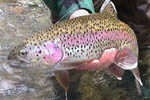|
I
have always enjoyed "chucking and ducking" weighted nymphs upstream
into a current. But
needing help with strike detection, my nymphing was aided by a
hard foam indicator (a bobber!) twisted onto the fly line.
This all changed in
the Spring of 2001, when Ed Laine of Charlotte, North
Carolina sent me a section of old fly line and a few samples of
one-inch indicators made from it.
HOW TO MAKE
THEM
Anyone who has
stripped insulation from copper wire will be able to
visualize the process of making these indicators.
-
With a single-edge
razor, cut the line's vinyl covering without cutting through the
nylon core. It is better to make shallow cuts rather than to
cut into the core. One-inch indicators are about
right. You can always cut them shorter afterwards to suit
your needs on the water. After all, an old fly line will
provide a lifetime supply of indicators!
-
Pour a little nail
polish remover into a container. I use a small recycled
margarine container. Soak the end of the line for about 10
seconds. This is usually enough.
-
Pull the vinyl
section off the nylon core, using your thumbnail and
fingernail. (Now you have a great reason to stop biting your
fingernails!)
HOW TO FISH
THEM
Fishing with these
indicators is easy. Just thread your fly line through one, and
slide it up the leader and over a knot to secure it in place.
For upstream fishing I usually place the indicator halfway up the
leader. If I
turn around and fish downstream I either leave the indicator as is
or slide it a little further up the leader.
For me, this is a
perfect system for fishing Buggers in streams and rivers. Most
people I know fish Buggers either by: (1) casting "across and
downstream" or (2) in deep water, casting "across and upstream", to
allow the fly to sink a bit before it swings downstream. The
fly-line indicator is so thin that it will not interfere with your
downstream fishing. Plus, if you turn around and face upstream
it will allow you to dead-drift a weighted Bugger with
confidence!
When you first fish
it, you will notice something that doesn't happen with foam
indicators. It sinks! But this is one of its many
advantages. First, you can generally see the indicator even
when submerged. I recommend fluorescent red or orange.
More importantly, because it is strictly an indicator and not a
bobber, it allows the fly to tumble along the bottom where the big
fish are.
In darker water and in
deep pockets I have lost track of the indicator on occasion.
When that happens I depend on the end of the fly line as my
indicator. This is not always satisfactory, as there can
be considerable slack in the leader, between the end of the fly line
and the fly, causing strikes to be missed. It has been
suggested that another option is to use two indicators. I have
not experimented with that yet.... But I will. Perhaps two 1/2-inch
indicators will do the trick.
If you are like me you
catch many tree fish and frequently get hung up on stream
bottoms. When fishing without an indicator, retrieving your
fly can usually be accomplished (on streams and small rivers,
anyway) by winding in your line, leader, and tippet until the fly is
nestled in the tip-top guide. Frequently a few shakes will
then free the fly. Fishing with foam indicators is always a
hassle because they must be removed first before you can perform the
rescue operation described above. But fly-line indicators are
so thin (after all, they are made from fly line) that they wind
right up, easily passing through the rod guides. No more
hassle!
WHY USE
INDICATORS?
I am a strong believer
in strike indicators. And the fly-line indicator is my
favorite style because it is so unobtrusive. It should help
even the best angler pick up more strikes. The reason for this
is that without an indicator all that you can see while nymphing is
the fly line tip. This is too far from the fly! There is
always some slack in the leader. This means some strikes go
undetected, or at the very least the detection is delayed.
With the fly-line indicator set, say, halfway up the leader, slack
in the butt half of the leader will not interfere with strike
detection because the fly line indicator will move first.
And, it will always
move before the end of the fly line moves.
Give it a
try.
--Peter Frailey |



